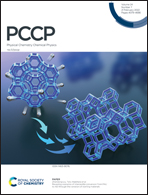A π-extended triphenylamine based dopant-free hole-transporting material for perovskite solar cells via heteroatom substitution†
Abstract
The triphenylamine (TPA) group is an important molecular fragment that has been widely used to design efficient hole-transporting materials (HTMs). However, the applicability of triphenylamine derived HTMs that exhibit low hole mobility and conductivity in commercial perovskite solar cells (PSCs) has been limited. To aid in the development of highly desirable TPA-based HTMs, we utilized a combination of density functional theory (DFT) and Marcus electron transfer theory to investigate the effect of heteroatoms, including boron, carbon, nitrogen, oxygen, silicon, phosphorus, sulfur, germanium, arsenic, and selenium atoms, on the energy levels, optical properties, hole mobility, and interfacial charge transfer behaviors of a series of HTMs. Our computational results revealed that compared with the commonly referenced OMeTPA-TPA molecule, most heteroatoms lead to deeper energy levels. Furthermore, these heteroatom-based HTMs exhibit improved hole mobility due to their more rigid molecular structures. More significantly, these heteroatoms also enhance the interface interaction in perovskite/HTM systems, resulting in a larger internal electric field. Our work represents a new approach that aids in the understanding and designing of more efficient and better performing HTMs, which we hope can be used as a platform to propel the developmental commercialization of these highly desirable PSCs.



 Please wait while we load your content...
Please wait while we load your content...